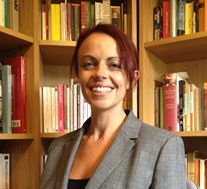24 September 2019 - Alex Goody
Published: 9 September 2019
Harlem Renaissance Women Poets and the City: Gender, Leisure and Technology
Talk: “Harlem Renaissance Women Poets and the City: Gender, Leisure and Technology”
Speaker: Alex Goody (Oxford Brookes University)
Tuesday 24 September 2019 at 5.15.
Venue: Room 202, 4 University Gardens, University of Glasgow.
Offering an energetic subculture that was often configured through essentializing notions of primitivism and racial alterity, Harlem gave the mobile cultural tourist access to a space of amusement that seemed an escape from the Anglo-normative regimes of Manhattan. It is the articulation of this touristic Harlem with the forces of the Harlem Renaissance and the technologies of the urban environment that this paper explores with a particular focus on the bodies and subjectivities of women and the politics of gender. African American women poets such as Helene Johnson, Blanche Taylor Dickinson, Gwendolyn Bennet, Bessie Mayle and Marjorie Marshall who responded to the urban environment and were associated with the Harlem Renaissance faced specific barriers to articulating an active agency in the city and to deconstructing the sedimented and naturalized norms of gender. I argue that their work offers distinct strategies for disturbing the oppositions between natural and artificial that seemed to be enforced by the commodification of the nightlife of Harlem and the gendered rhetoric of the Harlem Renaissance.
There is a foundational ambivalence in Harlem Renaissance women’s city poems but, nevertheless, there are striking instances of poets, Helene Johnson in particular, who write city lyrics that negotiate the complex network of positionality that situated African American women in discourse and social practice in the city. Their visibility in the city was marked by their gender but also by race and they were subject to the stereotyping “brown girl” rhetoric of the Harlem Renaissance and the New Negro vogue which defined a racial essence through the co-opted body of the primitivized African American woman. The city thus stands as a potential barrier to a woman’s voice because the African American woman is objectified by the exploitative machines of advertising, fixed in the exoticizing white imaginary and cast, against the techno-modernity of the city, as an essentialized, and positively invested, racial body. My analysis of their poetry in this paper identifies how, when writing of an urban experience, Harlem Renaissance women poets adopt a range of strategies to reinscribe their becoming-subjectivities into the power dynamics and social, cultural and technological architectures of the city.
Alex Goody is Professor of Twentieth-Century Literature and Culture at Oxford Brookes University and specializes in the areas of modernist and avant-garde studies, women’s writing, technology and literature, and media and cultural studies. She is the author of Modernist Articulations: a cultural study of Djuna Barnes, Mina Loy and Gertrude Stein (2007) and Technology, Literature and Culture (2011), and co-editor of American Modernism: Cultural Transactions (2009), Mapping the Self: Place, Identity, Nationality (2015) and Reading Westworld (2019). Her latest book, Gender, Leisure Technology and Modernist Poetry: Machine Amusements will be published by Palgrave at the end of 2019, and she is currently co-editing the Edinburgh Companion to Modernism and Technology (for publication in 2021) and a collection on Reading Black Mirror. Alex’s new monograph project is tentatively entitled Of Women and Other Animals.
First published: 9 September 2019
For further information, please contact Dr Laura Rattray: Laura.Rattray@glasgow.ac.uk
This series is generously funded by the British Association for American Studies / United States Embassy Small Grants Programme.




